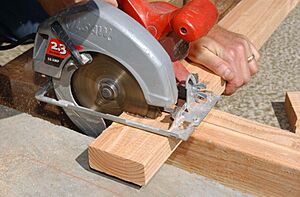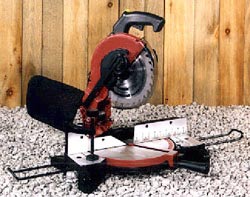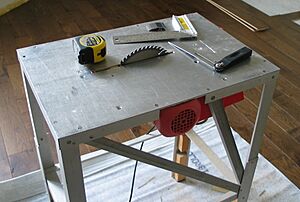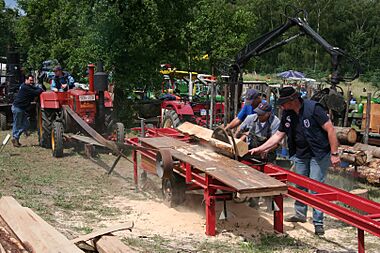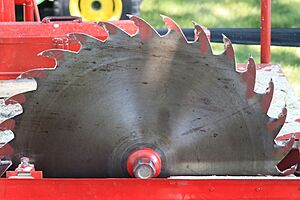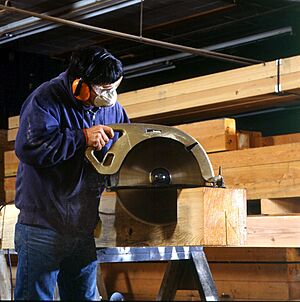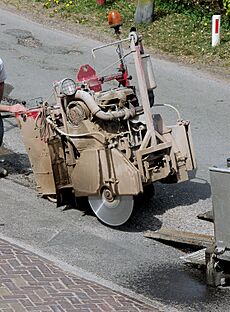Circular saw facts for kids
A circular saw is a powerful tool. It uses a round, spinning blade to cut many different materials. These materials can include wood, metal, plastic, or even stone. The blade spins very fast around a central rod called an arbor. Sometimes, people also call the blade itself a "circular saw."
Circular saws are very useful tools. They can be held by hand or built into a larger machine. In woodworking, "circular saw" often means the hand-held type. Other common types include the table saw and the chop saw. Circular saw blades are made for specific jobs. For example, some blades cut wood along the grain (rip-cuts). Others cut across the grain (cross-cuts). Most circular saws run on electricity. Some use gasoline engines or hydraulic motors for heavy-duty work.
Contents
History of Circular Saws
People may have used early forms of circular saws long ago. Evidence suggests the Indus Valley Civilization used them in the Bronze Age. This was found at an old site called Lothal in India.
The modern circular saw was invented in the late 1700s. It was first used in sawmills to cut large logs into lumber. Before this, people cut logs by hand using a pit saw. Or, sawmills used "up-and-down" saws that moved back and forth. The circular saw was different because its blade spun in a circle. This needed more power but cut much faster. Because of the sound it made, it was often called a buzz-saw.
Early sawmills used smaller circular saws. They cut smaller pieces of wood like lath or studs for walls. As technology improved, very large circular saw blades were made. These could cut huge logs and even make clapboards.
Many people are said to have invented the circular saw:
- Samuel Miller of England got a patent in 1777 for a saw windmill. But his patent did not focus on the saw itself.
- Gervinus of Germany is often given credit for inventing it in 1780.
- Walter Taylor of England had circular saws in his sawmill around the 1790s. He did not patent the saw, though.
- Some believe it came from the Netherlands in the 1500s or 1600s.
- Tabitha Babbitt, a Shaker inventor, is sometimes said to have invented a large circular saw in 1813. She wanted to make log cutting more efficient. However, this claim is mostly not believed today.
How a Circular Saw Works
When you use a circular saw, the material you want to cut is usually held firmly. Then, the saw slowly moves across it. On a table saw, the saw blade stays still. You push the material slowly into the spinning blade.
As each tooth on the blade hits the material, it cuts off a small piece. The teeth are designed to guide these small pieces away. This stops the blade from getting stuck in the material.
Key Features
- It cuts using teeth on a metal blade or a special abrasive wheel.
- The cut it makes is usually straight and smooth.
- It often leaves small rough edges, called burrs, on metal or plastic. These need to be smoothed later.
Types of Circular Saws
Besides the hand-held saws, many other tools use circular blades. Here are some common ones:
- Abrasive saw: Cuts hard materials like concrete.
- Miter saw: Used to make angled cuts, often for trim or frames.
- Panel saw: Cuts large sheets of wood or plastic.
- Radial arm saw: The saw moves along an arm to cut wood.
- Table saw: The blade sticks up through a table, and you push the wood across it.
- Track saw: A saw that runs along a guide rail for very straight cuts.
Sawmill Blades
In the past, sawmills used smaller circular saw blades. They would cut lumber that had already been partly cut by "up and down" saws. This made it easier to cut small pieces of wood.
After the early 1800s, sawmills started using very large circular saws. Some blades were up to 3 meters (10 feet) wide! These huge saws needed a lot of power. They became practical when steam engines were invented. These large blades often have replaceable teeth.
Hand-Held Circular Saws for Wood
When people talk about a "circular saw" in woodworking, they usually mean a hand-held electric saw. These saws are mainly for cutting wood. But you can cut other materials if you use the right blade.
Circular saws can be "left-handed" or "right-handed." This depends on where the motor is placed. A left-handed saw is often easier for a right-handed person to use. This is because they can see the cutting line better.
Most blades for cutting wood have tungsten carbide tips. These tips make the blade very strong and sharp. You can adjust the saw's base to change how deep it cuts. You can also tilt the blade to make angled cuts. Different saws use different blade sizes, from about 14 cm (5.5 inches) to 61 cm (24 inches).
There are two main ways the motor connects to the blade:
- Sidewinder saws: The blade is directly on the motor's shaft.
- Worm-drive saws: The motor is placed differently and uses gears. This gives the saw more power (torque).
The worm-drive portable circular saw was invented in 1923 by Edmond Michel. He and Joseph Sullivan started a company to make and sell this saw. Their company later became Skilsaw Inc.. Many people still call hand-held circular saws "Skilsaws." Today, smaller cordless circular saws that run on batteries are very popular.
Cold Saws for Metal
Cold saw Cold saws are circular saws used to cut metal. Their blades are quite large and spin slowly. They cut by making narrow slots in the metal. The metal is usually held tightly in a vise while it's being cut. The blade's teeth and special cooling liquid help remove the metal chips.
Abrasive Saws
The spinning motion of a circular saw is great for cutting very hard materials. These include concrete, asphalt, metal, tile, brick, and stone. These saws use special abrasive blades, like Diamond blades or cut-off wheels.
Images for kids
See also
- Band saw
- Dado set
- Hewing
- Saw pit
- Water mill
- Wood splitting


